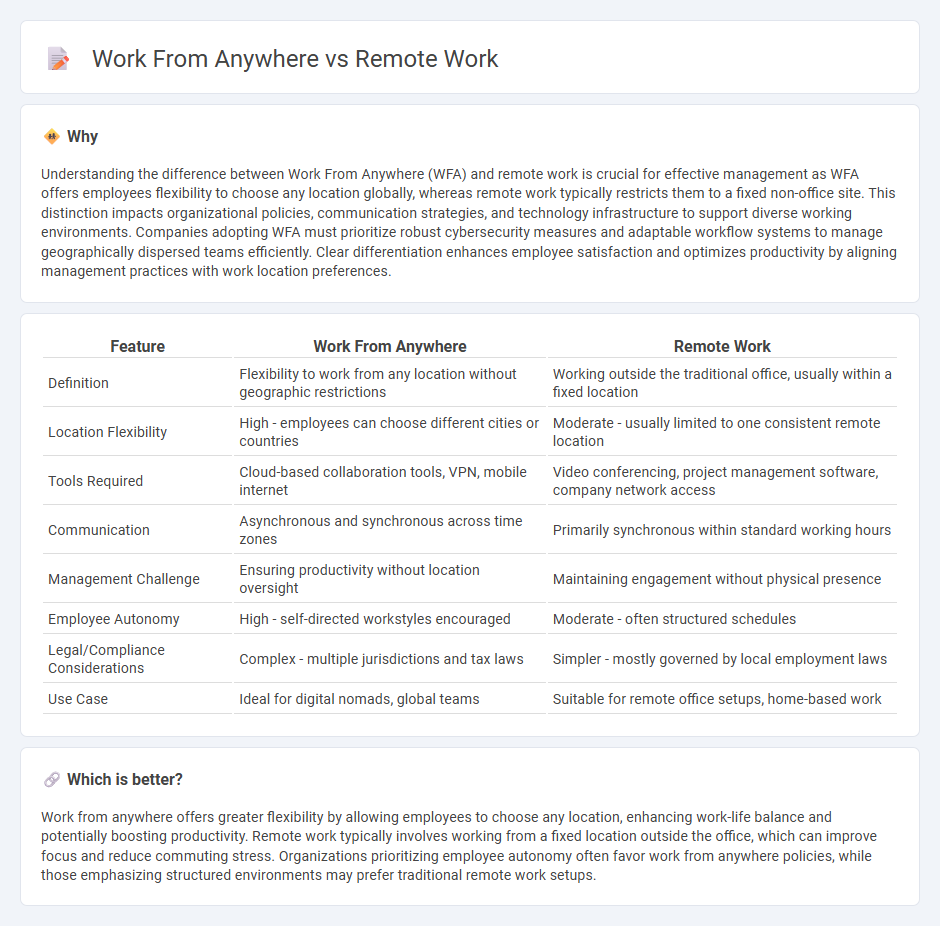
Work from anywhere allows employees to perform tasks from any location without geographic restrictions, promoting flexibility and a better work-life balance. Remote work typically refers to working from a designated home office or specific remote location, often with structured schedules and tools to maintain productivity. Explore the key differences and benefits to determine the best approach for your organization.
Why it is important
Understanding the difference between Work From Anywhere (WFA) and remote work is crucial for effective management as WFA offers employees flexibility to choose any location globally, whereas remote work typically restricts them to a fixed non-office site. This distinction impacts organizational policies, communication strategies, and technology infrastructure to support diverse working environments. Companies adopting WFA must prioritize robust cybersecurity measures and adaptable workflow systems to manage geographically dispersed teams efficiently. Clear differentiation enhances employee satisfaction and optimizes productivity by aligning management practices with work location preferences.
Comparison Table
| Feature | Work From Anywhere | Remote Work |
|---|---|---|
| Definition | Flexibility to work from any location without geographic restrictions | Working outside the traditional office, usually within a fixed location |
| Location Flexibility | High - employees can choose different cities or countries | Moderate - usually limited to one consistent remote location |
| Tools Required | Cloud-based collaboration tools, VPN, mobile internet | Video conferencing, project management software, company network access |
| Communication | Asynchronous and synchronous across time zones | Primarily synchronous within standard working hours |
| Management Challenge | Ensuring productivity without location oversight | Maintaining engagement without physical presence |
| Employee Autonomy | High - self-directed workstyles encouraged | Moderate - often structured schedules |
| Legal/Compliance Considerations | Complex - multiple jurisdictions and tax laws | Simpler - mostly governed by local employment laws |
| Use Case | Ideal for digital nomads, global teams | Suitable for remote office setups, home-based work |
Which is better?
Work from anywhere offers greater flexibility by allowing employees to choose any location, enhancing work-life balance and potentially boosting productivity. Remote work typically involves working from a fixed location outside the office, which can improve focus and reduce commuting stress. Organizations prioritizing employee autonomy often favor work from anywhere policies, while those emphasizing structured environments may prefer traditional remote work setups.
Connection
Work from anywhere and remote work both emphasize flexibility in location, enabling employees to perform tasks outside traditional office settings. Remote work typically refers to a fixed alternative workplace like home, while work from anywhere expands this concept by allowing employees to choose any location globally. These practices rely on digital collaboration tools and effective management strategies to maintain productivity and communication.
Key Terms
Flexibility
Remote work typically involves employees performing their duties outside the traditional office, often from a fixed location such as home, providing a consistent and controlled environment. Work from anywhere expands this concept by allowing employees to choose any location globally, offering unparalleled flexibility and autonomy in balancing personal and professional life. Explore how embracing these flexible work models can transform productivity and employee satisfaction.
Location Independence
Remote work allows employees to perform their duties outside the traditional office, usually from a fixed alternative location such as home, whereas work from anywhere offers complete location independence, enabling employees to work from any place worldwide. Embracing location independence enhances productivity, fosters work-life balance, and attracts top talent in a global job market. Discover how adopting flexible work models can revolutionize your organization's approach to employee empowerment.
Productivity
Remote work typically involves employees working from a fixed location outside the traditional office, such as a home office, while work from anywhere offers greater flexibility by allowing employees to choose any location globally. Studies indicate that work from anywhere can boost productivity by reducing commuting stress and increasing autonomy, but it requires robust digital infrastructure and strong communication practices. Discover comprehensive insights on maximizing productivity through these flexible work models.
Source and External Links
What Is Remote Work? Ultimate Guide - Remote work involves employees working from home or other locations outside the company's physical office, often using digital tools for collaboration.
How to Embrace Remote Work - This guide provides tips and strategies for creating a productive and collaborative remote team, emphasizing company culture and digital tools.
Working Nomads: Remote Jobs - Discover fully remote job opportunities worldwide for digital nomads and remote workers, including full-time, part-time, and contract roles.
 dowidth.com
dowidth.com